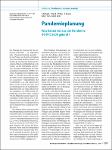Pandemieplanung
Was haben wir aus der Pandemie (H1N1) 2009 gelernt?
Schaade, Lars
Reuss, Annicka
Haas, Walter
Krause, Gérard
Seit 2001 wurde in Deutschland systematisch Pandemieplanung von Bund und Ländern betrieben. Die Umsetzung der Planungen war fortgeschritten und hat in ihrer Gesamtheit mit großer Wahrscheinlichkeit dazu beigetragen, dass die Auswirkungen der Pandemie (H1N1) 2009 in Deutschland gut kontrolliert werden konnten. Anpassungs- und Vorbereitungsbedarf der Pandemieplanung zeigen sich aufgrund der Erfahrungen während der Pandemie (H1N1) 2009 vor allem im Bereich der Impflogistik und der Kommunikation. Sowohl der nationale als auch der WHO-Pandemieplan sollten künftig deutlicher zwischen Warnphasen zur Vorbereitung von Strukturen und epidemiologischen Lagen zur Aktivierung von Maßnahmen unterscheiden. Eine weitere Herausforderung bleibt die Balance zwischen national einheitlichem Vorgehen und örtlicher Anpassung von Maßnahmen an die jeweilige Lage. Auch wenn die Pandemie (H1N1) 2009 moderat verlief, bleibt die Pandemieplanung von größter Bedeutung und muss gemäß den Erfahrungen konsequent und frühzeitig weiterentwickelt werden. Since 2001, the German states and federal institutions have been engaged in systematic pandemic preparedness planning. Preparedness was largely in an advanced stage and most probably contributed to successful control of the influenza H1N1 (2009) pandemic in Germany. Adaptation and improvement are needed most in the fields of vaccine logistics and communication. In the future, the national plan as well as the WHO pandemic plan should distinguish more clearly between pandemic warning phases for preparation of structures, on the one hand, and epidemiologic situations for activation of measures, on the other hand. The proper balance between a uniform national approach and the local adaptation of measures within Germany remains another challenge. Although the course of the influenza pandemic (H1N1) 2009 was moderate, pandemic preparedness planning remains of utmost importance and must be adapted rigorously and early according to the recent experience.
No license information

